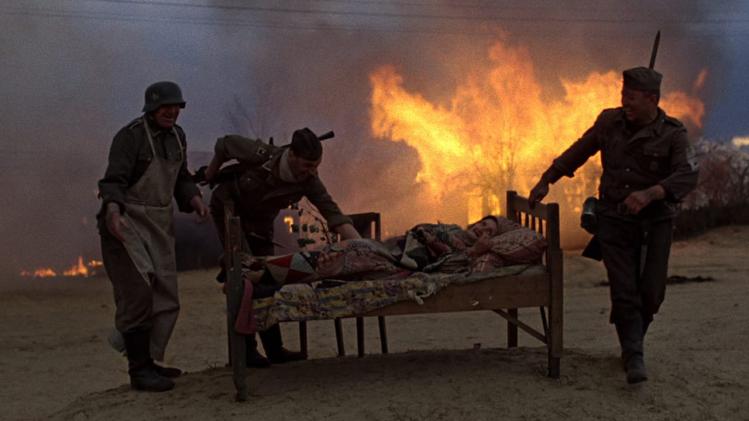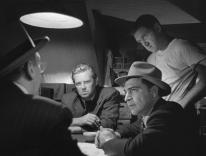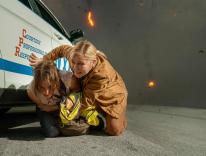
Midway through his novel Seiobo There Below, László Krasznahorkai tells the story of a master woodcarver at work on a Noh mask. Through one long lilting sentence, we follow the man’s daily routine and the slow emergence of the mask from a block of hinoki cypress: from its original conception, through the first hesitant strokes, all the way to its final adornment with liquid metal. The process is painstaking and frequently dangerous, “a life-threatening, perilous labyrinth, where in every single movement of every single phase of the work there exists the possibility of error.” At the very end of this process, the face of the shiro-hannya appears in all its sublime ferocity. But what the artist does not even suspect is that “what his hands have brought into the world is a demon, and that it will do harm.”
In Gravity and Grace, Simone Weil draws an explicit link between aesthetic and physical violence, writing: “Even in my worst moments I would not destroy a Greek statue or a fresco by Giotto. Why anything else then? Why, for example, a moment in the life of a human being who could have been happy for that moment.” In this view, violence splinters the world and leaves trauma in its wake. It is no surprise that proto-fascists like Gabriele D’Annunzio and the Italian Futurists elevated violence to a kind of sublime aesthetic force. For them, extreme actions had become necessary to achieve individual fulfillment in a hopelessly decadent world.
Even today, many artists are tempted to envision a world transformed by dramatic violence. Don DeLillo posited terrorism as “the only meaningful act” in Mao II. Marilynne Robinson has said that her students at the Iowa Writers Workshop often enjoyed punishing their characters. And Ida Jessen, a writer who has translated Robinson into Danish, told me something similar last fall: that the highest aspiration of modernism is cruelty. Even Krasznahorkai’s latest work often falls prey to a spiteful irony, where no good intention exists but to be thwarted. Weil seems lonely in her avowal, “To sully nothing, even in thought.” Anyone who makes violent art, no matter how finely wrought, runs the risk of creating a demon.
This is especially true when that art deals with real-life atrocities. In an interview around his 2012 film Amour, the Austrian director Michael Haneke presented a critique of Steven Spielberg’s Schindler’s List and other films about the Holocaust. To create suspense around whether gas or water will come out of a showerhead, according to Haneke, is an “unspeakable” act that reduces human suffering to a form of entertainment.
I returned to this interview a few months ago when Amazon released the neo-exploitation series Hunters on its streaming service. Hunters reimagines the hunt for Nazi fugitives as a kind of high camp, its cast stocked full of every imaginable grindhouse archetype. Every gesture seems secondhand. But as it cuts between 1970s New York and the death camp at Auschwitz, the show descends to a level of stupidity not even camp can justify. When a band of Jewish musicians switches from Wagner to folk music, they are executed on the spot. A chess prodigy is forced to play against an SS commander, with Jewish prisoners as the chess pieces. And the entire plot hinges around a maniacal Nazi, the Wolf, a genius so devious he spends the entire show hiding in plain sight.
I’m not the first person to find the show distasteful—the Auschwitz Memorial registered a complaint early on. I’m not even the first to note how incredibly tacky it all is. But it occurred to me recently that the outrageous images in Hunters serve as a kind of shield against the true horrors of the Holocaust. The show elevates the perpetrators of this world-historic crime to the status of fascinating arch-villains, while reducing its victims to plot devices. It is unspeakable, to use Haneke’s word. It is also ridiculous.
Several weeks before New York City began to shut down, I spent a late night at Film Forum watching a restoration of the Soviet filmmaker Elem Klimov’s 1985 masterpiece Come and See, widely regarded as one of the most excruciatingly violent movies ever made. It was a genuinely overwhelming experience, one that I couldn’t get out of my mind for weeks.
Come and See portrays the Nazi terror in Soviet Byelorussia through the eyes of Flyora, a teenage boy from a poor village. It is 1943. Ignoring a warning from a village elder, Flyora goes off to join the partisans with a rifle he and a friend dug out of the sand. Nothing goes as Flyora hopes: he is left behind when the partisans march off; he returns home to find the villagers slaughtered against his family barn. The untrained Aleksei Kravchenko, who plays Flyora, alternates throughout the film between giddy laughter and howls of desperation, his consciousness unable to accept what is, by any normal reckoning, an unacceptable reality.
The occupation of Byelorussia was remarkably brutal, even for the Nazis. In Minsk, the German army forced Jews to march before propaganda cameras before shooting them over pits. Prominent Jewish intellectuals were publicly humiliated, women forced into sex slavery. By January 1942 the Germans had already killed 190,000 Byelorussians.
Drawing a line eastward, the Nazis separated the rich “black earth” of Ukraine from the swamps, forests, and sand dunes to the north. While Ukrainian peasants were useful for slave labor, the Byelorussian Untermenschen were marked for starvation. The landscape became one of fierce conflict between partisans and Nazis, who destroyed over 5,000 villages and settlements as reprisals for partisan attacks. In the years immediately after the war, much of western Soviet Byelorussia would be riven with fierce campaigns of ethnic cleansing. And then, less than a year after Come and See premiered, the region was bathed in fallout from Chernobyl.
Klimov frequently draws our attention to the tiniest of details, from an unborn chick crushed beneath a boot heel to the twisted knot that a bullet burrows into a tree trunk to the berserk oscillation of a dying cow’s eye. Only in the film’s nearly hour-long climax does the perspective move away from Flyora, the steadicam gliding out and around a small village as SS soldiers and collaborators move in from the fog, drive villagers into a vandalized church, and then burn them all alive. Klimov depicts the event in all its vicious and frequently grotesque detail, from the collaborators who take particular joy in rounding up their countrymen to the Nazi general’s pet marmoset.
Despite its similarities with horror and survival movies, Come and See is not about suspense. The question is never if Flyora will survive, but only what he will have to endure in order to survive. Unlike some of his imitators, Klimov prefers to focus on the effect of violence, rather than on the violence itself. If memory serves, only one character dies onscreen.
Many films have been made about the senselessness and brutality of war. But they usually fail in their mission because, as François Truffaut pointed out, they transform war into excitement, and thus into entertainment. Even some of the most profound films in this genre, such as Terrence Malick’s Thin Red Line, try to find a place for war in the great span of the universe, transfiguring human cruelties into cosmic forces.
Come and See is without question a brutal film, and full of suffering. But while Klimov does not shy away from the ugliness of war and poverty, he also sees the forests, the fields, the jokes that children make, and even some hints of transcendence. As Flyora flees back to his home village with a woman named Glasha, we pass from delirious visions of rain and sunlight to an image that I can’t shake: a crane stalking up into their makeshift lean-to to gaze at them with its impenetrable black eyes. What is the crane doing? What is it thinking? Klimov never tells us why it tags along behind the pair. There is no setting too bleak for visionary moments like this one.
Elsewhere in Gravity and Grace, Weil argues that “to say that the world is not worth anything, that life is of no value, and to give evil as the proof is absurd, for if these things are worthless what does evil take from us?” Klimov seems intent on depicting the scale of that loss. His characters are never treated as replaceable parts in the machinery of atrocity, but rather as individual perpetrators and sufferers, indelibly characterized in brief moments.
We observe these horrors not only through but frequently in Flyora’s eyes, Aleksei Rodionov’s extreme close-ups tracing the boy’s joy and despair along the bridge of his nose and under the hollows of his eyes. But the climax ends not with Flyora, but with an old woman left on a bed in the middle of the burning village, the fires shadowing her many wrinkles as her entire world burns.
Come and See begins with Flyora getting his hands on a rifle, but only when the movie is almost over does he actually shoot it. He fires again and again into a portrait of Hitler, and suddenly Klimov jumps to stock images shown in reverse chronological order. Shot, the invasion of Poland; shot, the rise of Hitler; shot, the 1920s; shot, World War I. With Flyora’s final shot, we see a photo of Hitler as a baby, held aloft in his mother’s arms.
On first viewing, I was convinced that Klimov was simply reminding us that violence can transform a small child into someone like Hitler. But when I watched it again, Klimov’s point struck me as more ambiguous. In Hunters, violence achieves justice through a kind of equilibrium: eye for an eye, pound for a pound. But Klimov holds no such illusions. The shots Flyora fires won’t redeem him, but they won’t turn him into a monster either. We see that there is still some goodness and vulnerability left in his prematurely aged face as he looks at the portrait, and begins to sob.
All the moments of banality and brutality, beauty and trauma, follow one another throughout the film without resolution. There are many useless and insignificant things about life, all those contradictions that enrage the outrageous simplicity of the fascist mind. Just because these things do not matter does not mean they exist merely to be destroyed.
In the conclusion to his mammoth study Bloodlands: Europe Between Hitler and Stalin, Timothy Snyder argues that to identify with victims only in their last moments is insufficient. “The victims were people; a true identification with them would involve grasping their lives rather than grasping at their deaths.” When Flyora is invited to hide in a farmhouse in the village that is about to be destroyed, the farmer introduces him to every member of his extended family: children, grandchildren, sons-in-law, and more. All but one of them will be killed before the film ends. But for a short time, their faces and names and gestures intimate a small, private world that will never exist again. Klimov is reminding us that atrocity consists of the severing of a million intimate bonds. “It is for us as humanists to turn the numbers back into people,” Snyder concludes. “If we cannot do that, then Hitler and Stalin have shaped not only our world, but our humanity.”
Please email comments to [email protected] and join the conversation on our Facebook page.
Previous Story
The Harper’s Letter
Next Story
Trapped at the Border


